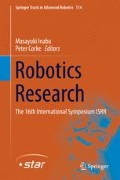Abstract
While, in nature, changes of morphology such as body shape, size, and strength play essential roles in animals’ adaptability in a variety of environment, our robotic systems today still severely suffer from the lack of flexibility in morphology which is one of the most significant bottlenecks for their autonomy and adaptability. With the ability to autonomously modify own body shapes or mechanical structures in surroundings, robotic systems could achieve a variety of tasks in flexible and simple manners. For this reason, we have been investigating technological solutions based on a class of unconventional material, the so-called Thermoplastic Adhesives (TPAs), with which the robots are able to construct their own body parts as well as connecting and disconnecting various mechanical structures. Based on our technological exploration so far, in this paper, we introduce the concept of “solving-by-building” approach, in which we consider how autonomous construction of mechanical parts can help robots to improve performances or to “solve” problems in given tasks. Unlike the conventional adaptive systems that can only learn motor control policies, the ability to change mechanical structures can potentially deal with a significantly more variety of problems. By introducing some of the recent case studies in our laboratory, we discuss the challenges and perspectives of the solving-by-building approach based on TPAs.
Access this chapter
Tax calculation will be finalised at checkout
Purchases are for personal use only
References
Adamatzky, A., Komosinski, M.: Artificial Life Models in Hardware. Springer, Berlin (2009)
Bongard, J.: Morphological change in machines accelerates the evolution of robust behavior. PNAS 108(4), 1234–1239 (2011)
Brodbeck, L., Iida, F.: Robotic body extension for flexible and scalable reaching, under review
Brodbeck, L., Wang, L., Iida, F.: Robotic body extension based on hot melt adhesives. In: Proceedings of the 2012 IEEE International Conference on Robotics and Automation (ICRA 2012), pp. 4322–4327. St Paul, USA, 14–18 May 2012
Christensen, A.L., O’Grady, R., Dorigo, M.: Morphology control in a multirobot system. IEEE Robot. Automat. Mag. 14(4), 18–25 (2007)
Diller, E., Pawashe, C., Floyd, S., Sitti, M.: Assembly and disassembly of magnetic mobile micro-robots towards deterministic 2-D reconfigurable micro-systems. Int. J. Robot. Res. 30, 1667–1680 (2011)
Hara, F., Pfefer, R.: Morpho-functional Machines. Springer, Berlin (2002)
Iida, F., Laschi, C.: Soft robotics: challenges and perspectives. Procedia Comput. Sci. 7, 99–102 (2011)
Johnston, T.D., Edwards, L.: Genes, interactions, and the development of behavior. Psychol. Rev. 109(1), 26–34 (2002)
Jones, R., Haufe, P., Sells, E., et al.: RepRap: the replicating rapid prototyper. Robotica 29, 177–191 (2011)
Kim, S., Laschi, C., Trimmer, B.: Soft robotics: a bioinspired evolution in robotics. Trends Biotech. 31, 287–294 (2013)
Klavins, E., Ghrist, R., Lipsky, D.: A grammatical approach to self-organizing robotic systems. IEEE Trans. Autom. Control 51(6), 949–962 (2006)
Kurokawa, H., Tomita, K., Kamimura, A., et al.: Distributed self-reconfiguration of M-TRAN III modular. Int. J. Robot. Res. 27(3–4), 373–386 (2008)
Langton, C.G.: Artificial Life: An Overview. MIT Press, Cambridge (1995)
Leach, D., Wang, L., Reusser, D., Iida, F.: In situ thermoplastic thread formation for robot built structures, in preparation (2013)
Li, W., Bouzidi, L., Narine, S.S.: Current research and development status and prospect of Hot-Melt-Adhesives: a review. Ind. Eng. Chem. Res. 47, 7524–7532 (2008)
Lipson, H., Pollack, J.: Automatic design and manufacture of robotic lifeforms. Nature 406, 974–978 (2000)
Nolfi, S., Floreano, D.: Evolutionary Robotics: The Biology, Intelligence, and Technology of self-Organizing Machines. MIT Press, Cambridge (2000)
Nurzaman, S.G., Culha, U., Brodbeck, L., Wang, L., Iida, F.: Active sensing system with in situ adjustable sensor morphology, under revision (2013)
Osswald, M., Iida, F.: Design and control of a climbing robot based on hot melt adhesion. Robot. Auton. Syst. 61(6), 616–625 (2013)
Pfeifer, R., Lungarella, M., Iida, F.: Self-organization, embodiment, and biologically inspired robotics. Science 318, 1088–1093 (2007)
Revzen S, Bhoite M, Macasieb A et al.: Structure synthesis on-the-fly in a modular robot. In: Amato, N. (ed.) Proceedings of the 2011 IEEE/RSJ IROS, pp. 4797–4802 (2011)
Sims, K.: Evolving 3d morphology and behavior by competition. In: Brooks, R., Maes, P. (eds.) Proceedings of the Artificial Life IV, 28–39. MIT Press, Cambridge (1994)
Steinberg, M.S.: Reconstruction of tissues by dissociated cells. Science 141(3579), 401–408 (1963)
Stoy, K., Brandt, D., Christensen, D.J.: Self-reconfigurable Robots: An Introduction. MIT Press, Cambridge (2010)
Wang, L., Brodbeck, L., Iida, F.: A parameterized-synthesis approach to the reconfiguration problem and its evaluation in pick-and-place, under review
Wang, L., Culha, U., and Iida, F.: Free-space locomotion with thread formation. In: The 2013 IEEE/RSJ International Conference on Intelligent Robots and Systems (IROS 2013), 3–7 November 2013, Tokyo Big Sight, Japan, accepted (2013)
Wang, L., Graber, L., Iida, F.: Large-payload climbing in complex vertical environments using thermoplastic adhesive bonds. IEEE Trans. Robot. in press (2013)
Wang, L., Iida, F.: Physical connection and disconnection control based on hot melt adhesives. IEEE-ASME Trans Mechatron (2012). doi:10.1109/TMECH.2012.2202558
White, P.J., Kopanski, K., Lipson, H.: Stochastic self-reconfigurable cellular robotics. In: Proceedings of IEEE International Conference on Robotics and Automation, 2888–2893 (2004)
Yim, M., Shen, W.M., Salemi, B., et al.: Modular self-reconfigurable robot systems: Challenges and opportunities for the future. IEEE Robot. Autom. Mag. 14(1), 43–52 (2007)
Yun, S., Rus, D.: Optimal self-assembly of modular manipulators with active and passive modules. Auton. Robot. 31(2–3), 183–207 (2011)
Acknowledgments
This research was supported by the Swiss National Science Foundation Professorship Grant No. PP00P2123387/1, the Swiss National Science Foundation through the National Centre of Competence in Research Robotics, and the ETH Zurich Research Grant ETH-23-10-3.
Author information
Authors and Affiliations
Corresponding author
Editor information
Editors and Affiliations
Rights and permissions
Copyright information
© 2016 Springer International Publishing Switzerland
About this chapter
Cite this chapter
Iida, F., Wang, L., Brodbeck, L., Leach, D., Nurzaman, S., Culha, U. (2016). The Solving by Building Approach Based on Thermoplastic Adhesives. In: Inaba, M., Corke, P. (eds) Robotics Research. Springer Tracts in Advanced Robotics, vol 114. Springer, Cham. https://doi.org/10.1007/978-3-319-28872-7_13
Download citation
DOI: https://doi.org/10.1007/978-3-319-28872-7_13
Published:
Publisher Name: Springer, Cham
Print ISBN: 978-3-319-28870-3
Online ISBN: 978-3-319-28872-7
eBook Packages: EngineeringEngineering (R0)

